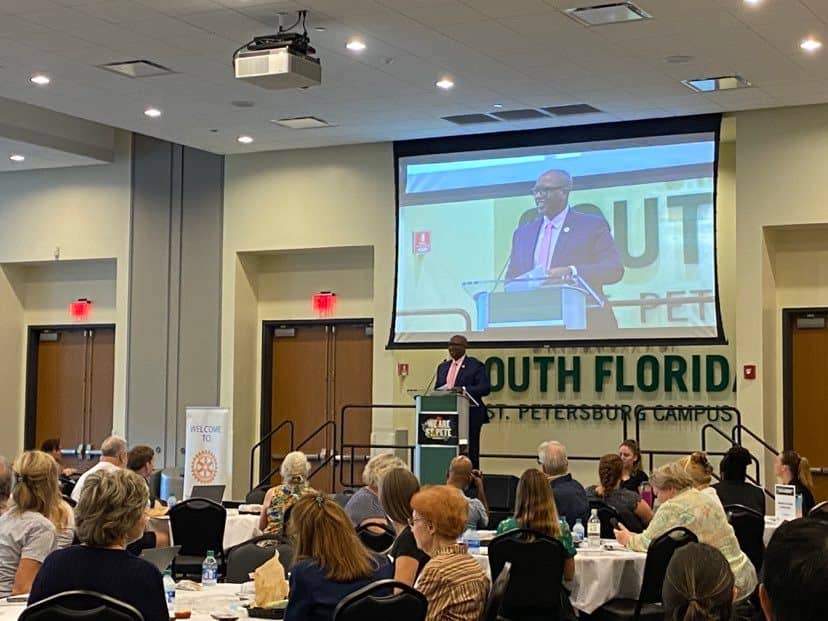Thrive
More than 1,000 offer Trop site suggestions

Hundreds of residents traveled to various locations, voicing their recommendations at the multiple community input sessions to determine the fate of the 86-acre Tropicana Field site, where the Gas Plant neighborhood once flourished.
Over the multiple public meetings packed into a one-month timeframe, the city has garnered nearly 1,000 engagements from the attendees participating in person, and those submitting responses online.
The last community input session, hosted by St. Petersburg Mayor Ken Welch, concluded Thursday evening at the University of South Florida’s St. Petersburg campus, where children from youth programs also provided feedback.
In every session, the participants were tasked with making suggestions on how the city and selected developer could successfully integrate workforce programs, affordable housing and other critical components as the collected suggestions will be used to help craft the language for the new request for proposals that will be advertised to developers in August.
Comments can still be submitted here.
The responses collected thus far touching the multiple components, according to the city, include:
- Integrate Booker Creek into the design and use it to activate surrounding neighborhoods
- Have flexible public space and outdoor open areas for local talent to perform and practice
- Youth and future workforce training, apprenticeships and career path opportunities
- Skill building pipelines for jobs being created
- Prioritize local hiring
- Have a variety of business types and sizes
- Have tansportation connections and affordable childcare
- Have affordable, attainable housing, including a social housing concept, for all ages
- Have a variety of suggestions related to housing programs such as a workforce development housing program and an innovator/entrepreneur in residence program
- Prioritize past Gas Plant residents for home ownership opportunities
- Provide pathways to ownership
As part of the sessions, Brian Caper, manager of public-private partnerships for the city, along with other city officials, presented aerial images of Tropicana Field and the 50-plus underutilized acres surrounding the stadium and compared it to how other cities across the U.S. have redeveloped its stadium sites.
The comparisons come as the new proposals from developers are required to have plans for a stadium at the site.
“This is a once-in-a-generation opportunity for impactful, inclusive progress, but it is not a stadium project, it’s a community project that will include a modern state-of-the-art home for the Rays,” Welch said to the crowd at USF St. Pete. “We need clarity on the path forward with respect to the Rays and this RFP process will give us that certainty.”
He expects to select a master developer by the end of the year.
What comes next
In a one-on-one interview, following his opening remarks at the campus, Welch told the St. Pete Catalyst that the next step involves assimilating the data of the responses in a usable format.
He said the city has already provided him the raw data.
“We will see what the trends were, the highest support and see some things we haven’t thought about,” he said. “The surprise has been the commonality of the priorities, whether it’s the first community input from South St. Pete or the conversation at the Downtown Partnership, which is a business group. So businesspeople versus grassroots folks, have the same primary issues. I think the recognition of the history is planned into that and to me, that’s what stands out.”
Since the announcement of Welch restarting the RFP process and traveling to various conferences and meetings with other mayors, he said leaders have provided positive feedback on his decision.
“We had overwhelming support, with them stating they would have done the same,” Welch said, reflecting on how the city’s needs have evolved over a decade from the demand for office space to affordable housing.
He also noted how the selected master developer will need to appropriately acknowledge the history of the site and develop programming that is “truly impactful.”
“What was lost was that sense of community when everyone was uprooted and sent everywhere,” he said, explaining how an endowment or fund could help sustain the community at the site.
Meanwhile, talks with the Rays about maintaining a presence and stake in the development are in motion.
“We continue to have a positive dialogue with the Rays. They have flexibility in how they choose to participate, whether it’s codeveloper or another format, but the important thing is the dialogue is active,” Welch said.
“I’m confident we are going to give this our best swing.”







Steve
July 30, 2022at6:08 pm
Still don’t understand why there isn’t a Wellness component in light of the proximity to the innovation/health district.